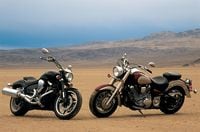This article was originally published in the April 2002 issue of Motorcycle Cruiser.
Yamaha scored a solid hit in 1999 when it introduced the Road Star. After a three-year attempt to attract premium cruiser buyers with its V-4 powered Royal Stars, which missed the target, the success of the Road Star finally gave the company some impetus at the top of the cruiser market. The engine, shaped by what buyers told Yamaha they wanted in a big cruiser, was air-cooled, had pushrod-operated valves (four per cylinder), and packed plenty of displacement. In '99, its 1602cc made it the biggest full-production V-twin on the market.
Now in its fourth year, the Road Star is virtually unchanged. It retains the classic American style it was born with. Full fenders sweep over wide 16-inch wire-spoke wheels. Fat fork tubes reach up past the big headlight to a wide handlebar. A big speedometer nestles into the top of the 5.3-gallon fuel tank. Floorboards confirm the relaxed character of the motorcycle. The large triangular chrome airbox and staggered dual mufflers frame the tall cylinders on the right. On the left, a belt delivers power to the rear wheel under a chrome guard. The price is $10,999 or $200 more if you want two-tone paint.
Although Yamaha has made a Silverado (windshield and leather saddlebags) version of the Road Star and a Midnight Star edition (with more chrome and polished parts and a deep black color), the Warrior is the first significant variation on the Road Star. The Warrior is almost entirely new, although it's built around the same basic 48-degree v-twin design. Instead of the easygoing approach of the Road Star, the Warrior is looking to kick some ass. New cylinders with bigger bores push displacement to 1670cc, and new heads flow more mixture to the combustion chambers, improve cooling and offer additional strength. New camshaft profiles raise its pulse too, and redesigned rockers accommodate the additional rpm. To help get mixture into the engine, there is a new fuel-injection system with two 40mm bodies replacing the standard Road Star's single 40mm carb. It plugs into an expanded airbox network, which displaces some of the fuel to an additional tank under the seat, though total capacity is just 4.0 gallons. Two equal-length header pipes move exhaust gases to that large single canister muffler. The ratios in the five-speed are juggled, though all are lower than the standard Star counterparts. The powerplant is finished in black.
The chassis is even more exotic than the engine, with an all-aluminum frame and swingarm that shorten the wheelbase over half an inch and steepen the steering head for more responsive handling. The 41mm inverted fork and dual-disc front brake components were lifted from the R1 sportbike and grafted to lightweight three-spoke cast wheels mounting radial tires, a 120/70-18 in front and a massive 200/50-17 on the six-inch wide rear wheel. The styling asserts the Warrior's aggressive nature, with a beautifully curved fuel tank, minimal fenders, a small headlight, and a thin saddle that gives only the briefest concession to a passenger. That lack of two-up intent is seconded by the passenger pegs, which are placed very high. Unique, blue-lit instrumentation includes a tachometer and multiple LCD windows. The Warrior lists for $11,999.


/cloudfront-us-east-1.images.arcpublishing.com/octane/ZFLEN5GEBJCXTJ72JLUO3QGHMQ.jpg)
/cloudfront-us-east-1.images.arcpublishing.com/octane/4RZQRGUTA5C2DMOEDGURJB4KRI.jpg)
/cloudfront-us-east-1.images.arcpublishing.com/octane/YJODDXEL2ZB5TENKPPN4BEYJAE.jpg)
/cloudfront-us-east-1.images.arcpublishing.com/octane/QEQQUZYNJFAIJB4DZFVFSNTCQ4.jpg)
/cloudfront-us-east-1.images.arcpublishing.com/octane/4OXL3PXHL5H3FAC7T5TCDX3S34.jpg)
/cloudfront-us-east-1.images.arcpublishing.com/octane/SUBBIQYDUNGJVHLA5TNHHRE3P4.jpg)
/cloudfront-us-east-1.images.arcpublishing.com/octane/4HLQB4W255HQ5GYOKOZNX7XKQA.jpg)
/cloudfront-us-east-1.images.arcpublishing.com/octane/F4VV6HPB55GIJABTHTQ2TM3ZQQ.jpg)
/cloudfront-us-east-1.images.arcpublishing.com/octane/DK7E3BPVEZAMXDKGXO4FY4JKA4.jpg)
/cloudfront-us-east-1.images.arcpublishing.com/octane/NAFNT7QSPNHSDHQ2SNCETHCRLI.jpg)
/cloudfront-us-east-1.images.arcpublishing.com/octane/VR253G637RGAHMEOM335EG2JMQ.jpg)
/cloudfront-us-east-1.images.arcpublishing.com/octane/SADSHCVUANAKVOZNPBEZW3AZNA.jpg)
/cloudfront-us-east-1.images.arcpublishing.com/octane/KFBYBE2JFVDGNFQU45I6ARG5WA.jpg)
/cloudfront-us-east-1.images.arcpublishing.com/octane/ZZNO6KMQ7RCILM3WVEPFUW44YI.jpg)
/cloudfront-us-east-1.images.arcpublishing.com/octane/ARDOSF3OGVCYTAPOKK66XYUEPY.jpg)
/cloudfront-us-east-1.images.arcpublishing.com/octane/VDADHHBS4NDN3LPASLBEPMN4GE.jpg)
/cloudfront-us-east-1.images.arcpublishing.com/octane/E3IGAU34MBBC3LIY6BEI5NVFKU.jpg)
/cloudfront-us-east-1.images.arcpublishing.com/octane/E7PLK4SZEFHXRNZVH2Z7GLZ2BY.jpg)
/cloudfront-us-east-1.images.arcpublishing.com/octane/FPHQ6O7HXFARVJ3L2ZYJIB4NBM.jpg)
/cloudfront-us-east-1.images.arcpublishing.com/octane/4XQZKUS5UJGY3IEBVERSNGGJ3U.jpg)
/cloudfront-us-east-1.images.arcpublishing.com/octane/A37VPL2PPRE3DGPBZI4V6N2IHE.jpg)
/cloudfront-us-east-1.images.arcpublishing.com/octane/JAF4HTUZ45GJBGM2MBOKB67DDE.jpg)
/cloudfront-us-east-1.images.arcpublishing.com/octane/JJ7MLEP34VBNPIJJKTZR472JOA.jpg)
/cloudfront-us-east-1.images.arcpublishing.com/octane/CC5ECSX765A7ZEKRA2QB363BME.jpg)